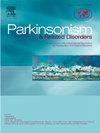Probabilistic mapping of gait changes after STN-DBS for Parkinson's disease
IF 3.4
3区 医学
Q2 CLINICAL NEUROLOGY
引用次数: 0
Abstract
Introduction
Gait disturbances causing impaired mobility are common in Parkinson's disease after bilateral deep brain stimulation of the subthalamic nucleus. We describe subthalamic subregions where neurostimulation had a positive effect on gait or provoked gait disturbances.
Methods
98 patients were classified according to changes in MDS-UPDRS III gait items: gait improvement (≥1-point improvement in items 3.10 and/or 3.11), gait deterioration (≥1-point worsening, confirmed by repeated clinical documentation), or no change. We performed a segregation analysis for (1) and (3) by simulating volumes of tissue activated and comparing aggregated spatial data and calculated probability maps to forecast gait performance and the parkinsonism control.
Results
42 patients experienced improvement of presurgical gait problems after stimulation. Seven patients showed gait deteriorations one-year post-implantation. Active contacts were more ventrally located for gait deterioration versus gait improvement. Voxel-wise probabilistic mapping of gait changes in the subthalamic area were able to forecast patient specific gait performance based on individual stimulation volume (LOOCV R2 = 0.45; p < 0.01) but was not associated with long-term parkinsonism control. Whereas a probabilistic map trained on MDS-UPDRS-III changes was predictive for clinical improvement in parkinsonism (R2 = 0.18; p < 0.01).
Discussion
Probabilistic mapping showed a strong correlation with therapy outcomes, especially gait improvement, and provided predictive value at the individual level. While the concept of sweet- or sourspots was insufficient to explain individual variability, the heatmap-based approach allowed symptom-specific topographies to be identified. Our findings support the use of probabilistic mapping as a valuable tool to guide individualized reprogramming strategies for improving mobility in Parkinson's disease.
帕金森病STN-DBS后步态变化的概率映射
在双侧丘脑下核深部脑刺激后,神经障碍引起的活动能力受损在帕金森病中很常见。我们描述了丘脑下亚区,其中神经刺激对步态有积极影响或引起步态障碍。方法98例患者根据MDS-UPDRS III步态项目的变化进行分类:步态改善(3.10和/或3.11项改善≥1分)、步态恶化(≥1分恶化,经反复临床文献证实)或无变化。我们对(1)和(3)进行了分离分析,通过模拟激活的组织体积,比较汇总的空间数据和计算的概率图来预测步态表现和帕金森病控制。结果42例患者经刺激后步态问题得到改善。7例患者在植入后1年出现步态恶化。对于步态恶化和步态改善,主动接触更多地位于腹侧。丘脑底区步态变化的体素概率映射能够基于个体刺激量预测患者的特定步态表现(LOOCV R2 = 0.45;p & lt;0.01),但与帕金森病的长期控制无关。然而,MDS-UPDRS-III变化训练的概率图可预测帕金森病的临床改善(R2 = 0.18;p & lt;0.01)。概率映射显示与治疗结果有很强的相关性,尤其是步态改善,并在个体水平上提供了预测价值。虽然甜点或酸点的概念不足以解释个体差异,但基于热图的方法允许识别特定症状的地形。我们的研究结果支持使用概率映射作为一种有价值的工具来指导个性化的重编程策略,以改善帕金森病的移动性。
本文章由计算机程序翻译,如有差异,请以英文原文为准。
求助全文
约1分钟内获得全文
求助全文
来源期刊

Parkinsonism & related disorders
医学-临床神经学
CiteScore
6.20
自引率
4.90%
发文量
292
审稿时长
39 days
期刊介绍:
Parkinsonism & Related Disorders publishes the results of basic and clinical research contributing to the understanding, diagnosis and treatment of all neurodegenerative syndromes in which Parkinsonism, Essential Tremor or related movement disorders may be a feature. Regular features will include: Review Articles, Point of View articles, Full-length Articles, Short Communications, Case Reports and Letter to the Editor.
 求助内容:
求助内容: 应助结果提醒方式:
应助结果提醒方式:


